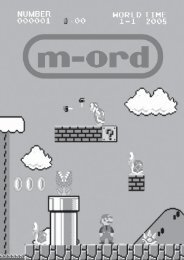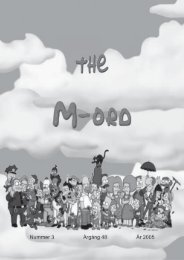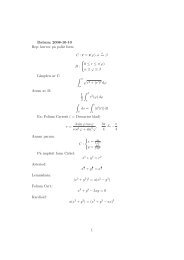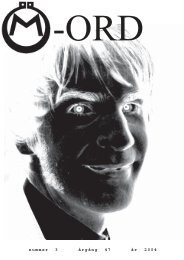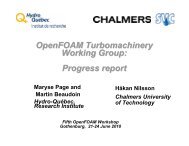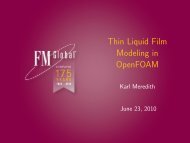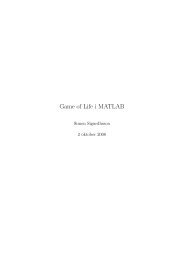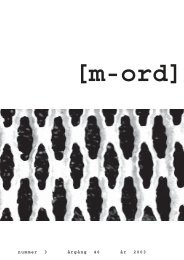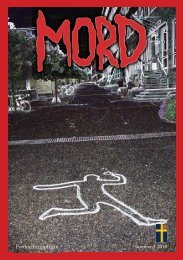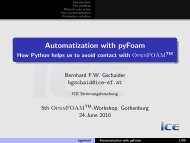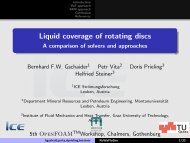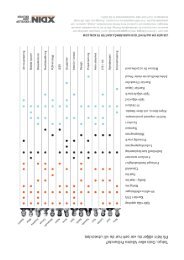An Open Source CFD-DEM Perspective
An Open Source CFD-DEM Perspective
An Open Source CFD-DEM Perspective
Create successful ePaper yourself
Turn your PDF publications into a flip-book with our unique Google optimized e-Paper software.
<strong>An</strong> <strong>Open</strong> <strong>Source</strong> <strong>CFD</strong>-<strong>DEM</strong> <strong>Perspective</strong><br />
Christoph Goniva<br />
Christoph Kloss<br />
Alice Hager<br />
Stefan Pirker<br />
Christian Doppler Laboratory on Particulate Flow Modelling<br />
Johannes Kepler University Linz<br />
www.cfdem.com | www.particule-flow.at
<strong>An</strong> <strong>Open</strong> <strong>Source</strong> <strong>CFD</strong> – <strong>DEM</strong> <strong>Perspective</strong><br />
Contents<br />
1. Introduction of the Laboratory<br />
2. Motivation<br />
3. The <strong>Open</strong> <strong>Source</strong> code LIGGGHTS / LAMMPS<br />
4. <strong>CFD</strong> – <strong>DEM</strong> coupling<br />
5. Validation example<br />
www.cfdem.com<br />
CD-Laboratory on Particulate Flow Modelling<br />
www.particulate-flow.at
<strong>An</strong> <strong>Open</strong> <strong>Source</strong> <strong>CFD</strong> – <strong>DEM</strong> <strong>Perspective</strong><br />
Introduction of the lab<br />
Founded in 2009 by Dr. Stefan Pirker at the<br />
Johannes Kepler University, Linz, Austria.<br />
Governmental funding (50-70%) for application<br />
oriented fundamental research based on existing<br />
knowledge on particulate flows at the Institute of<br />
Fluid Mechanics and Heat Transfer of the JKU.<br />
Our research focus covers:<br />
(a) solids charging,<br />
(b) offgas scrubbing,<br />
(c) industrial dust recycling,<br />
(d) sedimentation & erosion and<br />
(e) trickling beds<br />
Current Industrial partners:<br />
Siemens VAI Metals Technologies,<br />
voestalpine Stahl,<br />
voestalpine Donawitz,<br />
Polysius (ThyssenKrupp group)<br />
www.cfdem.com<br />
CD-Laboratory on Particulate Flow Modelling<br />
www.particulate-flow.at<br />
3
<strong>An</strong> <strong>Open</strong> <strong>Source</strong> <strong>CFD</strong> – <strong>DEM</strong> <strong>Perspective</strong><br />
Introduction of the lab<br />
CD-Laboratory on<br />
Particulate Flow Modelling<br />
Industrial Partners<br />
Offgas Scrubbing<br />
Solids Charging<br />
Industrial Dust Recycling<br />
Associated research<br />
Sedimentation & Erosion<br />
Tickling Bed<br />
www.cfdem.com<br />
CD-Laboratory on Particulate Flow Modelling<br />
www.particulate-flow.at
<strong>An</strong> <strong>Open</strong> <strong>Source</strong> <strong>CFD</strong> – <strong>DEM</strong> <strong>Perspective</strong><br />
Motivation<br />
Many applications require coupled <strong>CFD</strong>-<strong>DEM</strong> simulations !<br />
Unfortunately, the <strong>CFD</strong>-<strong>DEM</strong> Approach is CPU intensive …<br />
<strong>An</strong> efficient <strong>CFD</strong>-<strong>DEM</strong> solver is on need<br />
‣ Fast solver (both <strong>CFD</strong> and <strong>DEM</strong>)<br />
‣ Efficient parallelisation<br />
‣ Low license fees<br />
‣ <strong>Open</strong> access to source code<br />
‣ GPU acceleration for <strong>DEM</strong> is desirable to handle industrial scale processes<br />
<strong>Open</strong>Foam is already established as leading <strong>Open</strong> <strong>Source</strong> <strong>CFD</strong> toolbox…<br />
LIGGGHTS is a parallel efficient <strong>DEM</strong> solver<br />
www.cfdem.com CD-Laboratory on Particulate Flow Modelling www.particulate-flow.at<br />
5
<strong>An</strong> <strong>Open</strong> <strong>Source</strong> <strong>CFD</strong> – <strong>DEM</strong> <strong>Perspective</strong><br />
LAMMPS / LIGGGHTS<br />
LAMMPS =<br />
Large Atomic and Molecular Massively Parallel Simulator<br />
<strong>Open</strong><strong>Source</strong> under GPL, provided by Sandia National Laboratories since the<br />
mid 90‘s (http://lammps.sandia.gov/)<br />
Widely used (over 500 journal publications 2000-2009 using LAMMPS)<br />
see http://lammps.sandia.gov/papers.html<br />
LAMMPS has potentials for soft materials (biomolecules, polymers), solid-state<br />
materials (metals, semiconductors) and coarse-grained systems. It can be used<br />
to model atoms or, more generically, as a parallel particle simulator at the<br />
atomic, meso, or continuum scale.<br />
LAMMPS is a C++ code, it runs on single processors or in parallel using messagepassing<br />
techniques and a spatial-decomposition of the simulation domain.<br />
The code is designed to be easy to modify or extend with new functionality.<br />
It is very fast and also used on huge clusters (e.g. on Sandia Red Storm with 16k<br />
Quadcore nodes, simulations with 2 billion particles performed)<br />
www.cfdem.com CD-Laboratory on Particulate Flow Modelling www.particulate-flow.at<br />
6
<strong>An</strong> <strong>Open</strong> <strong>Source</strong> <strong>CFD</strong> – <strong>DEM</strong> <strong>Perspective</strong><br />
LAMMPS / LIGGGHTS<br />
Currently, LAMMPS offers a fast and efficient “GRANULAR” package for<br />
doing <strong>DEM</strong> simulations. Thereby, we profit from the fact that there are physical<br />
and algorithmic analogies between <strong>DEM</strong> and MD<br />
The key functionalities of this LAMMPS package are:<br />
‣ Pairwise interaction styles: Hooke and Hertz contact laws<br />
with optional friction<br />
‣ Granular walls: (Hooke and Hertz, with optional friction) for<br />
geometric primitives (box, cylinder)<br />
‣ Shear history for pairwise interaction and granular walls<br />
www.cfdem.com CD-Laboratory on Particulate Flow Modelling www.particulate-flow.at<br />
7
<strong>An</strong> <strong>Open</strong> <strong>Source</strong> <strong>CFD</strong> – <strong>DEM</strong> <strong>Perspective</strong><br />
LAMMPS / LIGGGHTS<br />
The key functionalities of this package are (continued):<br />
‣ A function to insert/pour a stream of material into a<br />
geometrical region<br />
‣ Functions to introduce gravity , freeze particles<br />
and exert Stokes drag<br />
‣ Multibody dynamics which can be modified to use it<br />
for handling of non-spherical particles<br />
‣ With pair style “hybrid/overlay”, other LAMMPS functionalities can be<br />
added easily (e.g. adding bonds, point charges, dipole moments,...)<br />
www.cfdem.com CD-Laboratory on Particulate Flow Modelling www.particulate-flow.at<br />
8
<strong>An</strong> <strong>Open</strong> <strong>Source</strong> <strong>CFD</strong> – <strong>DEM</strong> <strong>Perspective</strong><br />
LAMMPS / LIGGGHTS<br />
LIGGGHTS application example:<br />
www.cfdem.com CD-Laboratory on Particulate Flow Modelling www.particulate-flow.at<br />
9
<strong>An</strong> <strong>Open</strong> <strong>Source</strong> <strong>CFD</strong> – <strong>DEM</strong> <strong>Perspective</strong><br />
LAMMPS / LIGGGHTS<br />
Goals of the <strong>CFD</strong>EM Project:<br />
‣ Creating a <strong>CFD</strong>-<strong>DEM</strong> framework for high performance computing<br />
‣ Make LAMMPS feasible for industrial applications<br />
LIGGGHTS =<br />
LAMMPS IMPROVED FOR GENERAL GRANULAR AND<br />
GRANULAR HEAT TRANSFER SIMULATIONS<br />
WWW.LIGGGHTS.COM | WWW.<strong>CFD</strong>EM.COM<br />
www.cfdem.com CD-Laboratory on Particulate Flow Modelling www.particulate-flow.at<br />
10
<strong>An</strong> <strong>Open</strong> <strong>Source</strong> <strong>CFD</strong> – <strong>DEM</strong> <strong>Perspective</strong><br />
LAMMPS / LIGGGHTS<br />
The following challenges have been tackled with LIGGGHTS:<br />
Feature LAMMPS LIGGGHTS 1.0<br />
Complex wall import from CAD No Yes<br />
Improved pair style No Yes<br />
Moving mesh No Yes<br />
Pour nonspherical clumps<br />
(multisphere method)<br />
No<br />
Macroscopic cohesion model No Yes<br />
Heat transfer model No Yes<br />
In progress...<br />
Particle bonds with torques No In progress...<br />
Wall Stress <strong>An</strong>alysis No Yes<br />
6 dof solver No Yes<br />
www.cfdem.com CD-Laboratory on Particulate Flow Modelling www.particulate-flow.at<br />
11
<strong>An</strong> <strong>Open</strong> <strong>Source</strong> <strong>CFD</strong> – <strong>DEM</strong> <strong>Perspective</strong><br />
<strong>CFD</strong> – <strong>DEM</strong> coupling<br />
Theoretical background:<br />
f4<br />
f1<br />
f2 f3<br />
= +<br />
-(f1 + f2)<br />
αf,1<br />
αf,2<br />
-(f3 + f4)<br />
<strong>DEM</strong> with force on<br />
particles coming<br />
from <strong>CFD</strong><br />
<strong>CFD</strong> with adapted<br />
voidfraction<br />
and momentum sources<br />
www.cfdem.com<br />
CD-Laboratory on Particulate Flow Modelling<br />
www.particulate-flow.at<br />
12
<strong>An</strong> <strong>Open</strong> <strong>Source</strong> <strong>CFD</strong> – <strong>DEM</strong> <strong>Perspective</strong><br />
<strong>CFD</strong> – <strong>DEM</strong> coupling<br />
Theoretical background:<br />
Navier-Stokes equations for the fluid in presence of a granular phase<br />
∂α<br />
∂<br />
α f<br />
u f<br />
f<br />
∂ t<br />
ρ<br />
( α ρ u )<br />
f<br />
f<br />
f<br />
∂ t<br />
f<br />
+ ∇ ⋅<br />
( α ρ u )<br />
f<br />
+ ∇ ⋅<br />
f<br />
( α ρ u u ) p K ( u u ) ( )<br />
f f<br />
= −α<br />
∇ −<br />
fs f<br />
−<br />
s<br />
+ ∇ ⋅ α τ + α ρ g<br />
f<br />
f<br />
=<br />
f<br />
0<br />
fluid volume fraction<br />
fluid velocity<br />
τ, p stress tensor, pressure<br />
fluid density<br />
ρ f<br />
K fs<br />
f<br />
fluid solid momentum exchange term<br />
comprises drag force, Magnus and Saffman force, virtual mass force,...<br />
f<br />
f<br />
f<br />
www.cfdem.com<br />
CD-Laboratory on Particulate Flow Modelling<br />
www.particulate-flow.at<br />
13
<strong>An</strong> <strong>Open</strong> <strong>Source</strong> <strong>CFD</strong> – <strong>DEM</strong> <strong>Perspective</strong><br />
<strong>CFD</strong> – <strong>DEM</strong> coupling<br />
Theoretical background:<br />
Example for fluid solid momentum exchange Kfs :<br />
Gidaspow (1992): Hydrodynamics of Circulating Fluidized Beds, Kinetic Theory Approach. In Fluidization<br />
VII, Proceedings of the 7 th Engineering Foundation Conference on Fluidization, pages 75‐82<br />
α f<br />
> 0.8:<br />
K<br />
C<br />
d<br />
sl<br />
=<br />
3<br />
4<br />
C<br />
f<br />
d<br />
α<br />
24<br />
=<br />
α Re<br />
p<br />
p<br />
α<br />
f<br />
ρ<br />
f<br />
d<br />
p<br />
u<br />
f<br />
−<br />
( α Re )<br />
−2.65<br />
f<br />
( 1 0.15<br />
)<br />
0.687<br />
+<br />
f<br />
u<br />
p<br />
α<br />
p<br />
,<br />
,<br />
α f<br />
≤ 0.8:<br />
K<br />
sl<br />
α<br />
s<br />
= 150<br />
α<br />
f<br />
2<br />
μ<br />
d<br />
f<br />
2<br />
p<br />
α<br />
sρ<br />
f<br />
+ 1.75<br />
u<br />
f<br />
−<br />
d<br />
p<br />
u<br />
p<br />
.<br />
www.cfdem.com<br />
CD-Laboratory on Particulate Flow Modelling<br />
www.particulate-flow.at<br />
14
<strong>An</strong> <strong>Open</strong>-<strong>Source</strong> <strong>CFD</strong> – <strong>DEM</strong> <strong>Perspective</strong><br />
„LammpsFoam“<br />
init<br />
particle data<br />
<strong>Open</strong>Foam<br />
Solver<br />
LIGGGHTS<br />
end<br />
flow data<br />
www.cfdem.com CD-Laboratory on Particulate Flow Modelling www.particulate-flow.at<br />
15
<strong>An</strong> <strong>Open</strong> <strong>Source</strong> <strong>CFD</strong> – <strong>DEM</strong> <strong>Perspective</strong><br />
Implementation<br />
start<br />
<strong>DEM</strong> solver calculates<br />
100 time-steps,<br />
and transfers particle<br />
data to <strong>CFD</strong> solver<br />
<strong>CFD</strong> solver calculates<br />
1 time-step<br />
<strong>CFD</strong> solver fetches<br />
<strong>DEM</strong> particle data<br />
<strong>CFD</strong> solver searches<br />
cell each particle is in<br />
<strong>CFD</strong> solver calculates<br />
volume fraction and<br />
momentum coupling<br />
<strong>CFD</strong> solver transfers<br />
drag forces to <strong>DEM</strong><br />
www.cfdem.com CD-Laboratory on Particulate Flow Modelling www.particulate-flow.at<br />
16
<strong>An</strong> <strong>Open</strong>-<strong>Source</strong> <strong>CFD</strong> – <strong>DEM</strong> <strong>Perspective</strong><br />
Implementation<br />
“Chimera” approach for momentum exchange<br />
mesh for<br />
exchange fields<br />
K sl , α<br />
mesh for <strong>CFD</strong><br />
calculations<br />
<strong>DEM</strong> domain<br />
www.cfdem.com CD-Laboratory on Particulate Flow Modelling www.particulate-flow.at<br />
17
<strong>An</strong> <strong>Open</strong>-<strong>Source</strong> <strong>CFD</strong> – <strong>DEM</strong> <strong>Perspective</strong><br />
Validation example<br />
Pressure drop and onset of fluidization in a cylindrical granular bed:<br />
u f 0 – 0.02 m/s<br />
g 9.81 m/s 2<br />
μ f 1.5 e-4 m 2 /s<br />
ρ s 200 kg/m 3<br />
d s 0.001 m (10000 particles)<br />
Fluid boundary conditions<br />
Inital particle packing<br />
www.cfdem.com CD-Laboratory on Particulate Flow Modelling www.particulate-flow.at<br />
18
<strong>An</strong> <strong>Open</strong>-<strong>Source</strong> <strong>CFD</strong> – <strong>DEM</strong> <strong>Perspective</strong><br />
Validation example<br />
validation case, onset of fluidization<br />
inlet velocity<br />
void fraction<br />
www.cfdem.com CD-Laboratory on Particulate Flow Modelling www.particulate-flow.at<br />
19
<strong>An</strong> <strong>Open</strong>-<strong>Source</strong> <strong>CFD</strong> – <strong>DEM</strong> <strong>Perspective</strong><br />
Validation example<br />
pressure drop<br />
according to analytics, the<br />
minimum fluidization velocity is<br />
at 0.012 m/s<br />
www.cfdem.com CD-Laboratory on Particulate Flow Modelling www.particulate-flow.at<br />
20
<strong>An</strong> <strong>Open</strong>-<strong>Source</strong> <strong>CFD</strong> – <strong>DEM</strong> <strong>Perspective</strong><br />
Validation example<br />
Performance:<br />
excessive performance tests have not yet been carried out, a first hint:<br />
10000 particles<br />
1h for 1s simulation time<br />
on 2 2.4 GHz processors<br />
www.cfdem.com CD-Laboratory on Particulate Flow Modelling www.particulate-flow.at<br />
21
<strong>An</strong> <strong>Open</strong>-<strong>Source</strong> <strong>CFD</strong> – <strong>DEM</strong> <strong>Perspective</strong><br />
Validation example<br />
Partly fluidized bed (inhomogeneous velocity BC):<br />
Fluid boundary conditions<br />
Inital particle packing<br />
www.cfdem.com CD-Laboratory on Particulate Flow Modelling www.particulate-flow.at<br />
22
<strong>An</strong> <strong>Open</strong>-<strong>Source</strong> <strong>CFD</strong> – <strong>DEM</strong> <strong>Perspective</strong><br />
Validation example<br />
Partly fluidized bed (inhomogeneous velocity BC):<br />
www.cfdem.com CD-Laboratory on Particulate Flow Modelling www.particulate-flow.at<br />
23



